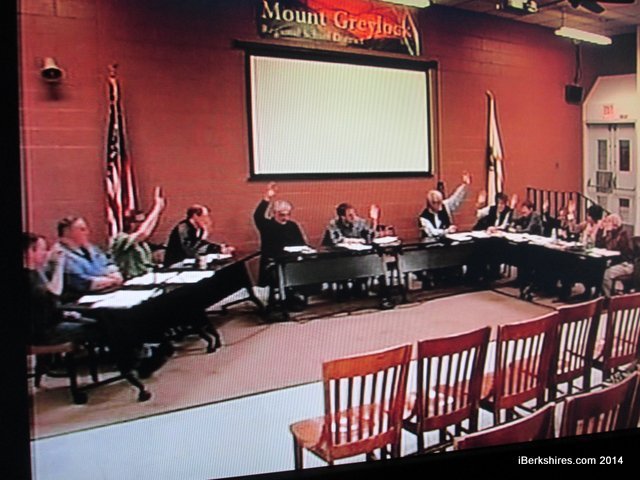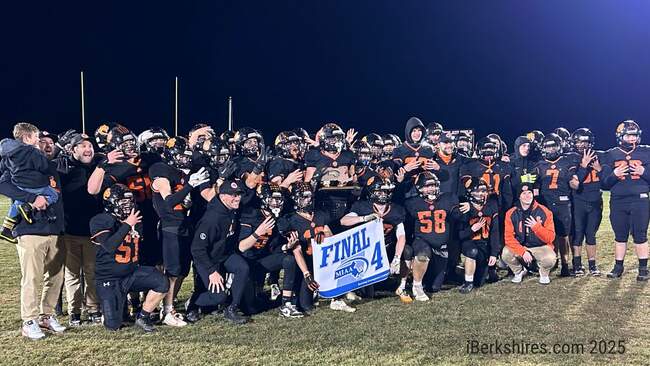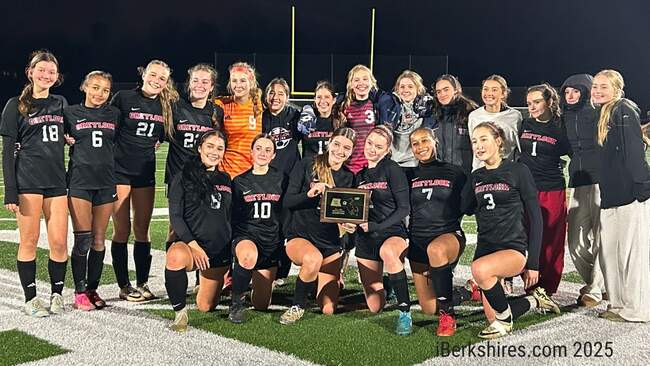Mount Greylock Building Committee: Keep Choice, Tuition Students
 The Mount Greylock Building Committee votes in favor of an enrollment projection that includes school choice and tuition students. The lone dissenter, Lanesborough's John Goerlach, is second from the left. The Mount Greylock Building Committee votes in favor of an enrollment projection that includes school choice and tuition students. The lone dissenter, Lanesborough's John Goerlach, is second from the left. |
WILLIAMSTOWN, Mass. — The Mount Greylock Regional School Building Committee on Thursday decided to recommend the district keep school choice and tuition students in the mix as the school moves forward in the Massachusetts School Building Authority process.
The School Committee next week must give MSBA an answer about what enrollment number to use if the district moves ahead in the authority's process to either renovate or replace the junior-senior high school.
The MSBA originally recommended a target enrollment 535 students based on demographic trends. Currently, the school has 585 students in Grades 7 through 12, but all signs point to a declining population in the county for the next several decades.
Based on conversations with one of Mount Greylock's two member towns, the School Committee asked MSBA to give it a second projection — one that assumed the district stopped accepting school choice and tuition students and only served residents of Williamstown and Lanesborough.
That figure came back as 450 students.
On Thursday, the Building Committee voted 10-1 to recommend the higher figure, 535, to the School Committee.
The lone dissenter was Lanesborough Selectman John Goerlach, who argued that the school district should not settle on a higher, more inclusive projection at a time when some residents in his town are advocating to restrict Mount Greylock to member-town residents on the argument that tuition and choice students do not bring enough revenue to cover the cost per student.
Goerlach's stance was supported from the floor of the meeting by Lanesborough Town Administrator Paul Sieloff.
Sieloff argued that the consideration of how large a building to build (or renovate) changes the way the district should look at tuition students.
"I was talking to someone from New Ashford, and he told me, 'Paul, people get angry at New Ashford or Hancock and say we're taking advantage, we pay less. ... But you gotta remember, you haven't built one classroom or added one desk for us. Everything we're bringing in is pretty much a benefit,' " Sieloff said.
"Now, we have a totally different conversation: Are we going to build extra space for non-resident students?"
Several Building Committee members argued for continuation of the tuition arrangement on two grounds: the cost of the additional space for choice and tuition students is not that great, and cost of removing those students — and the revenue they bring — would be dramatic.
Carolyn Greene, chairman of the School Committee, added a third argument: The district has negotiated a five-year deal with the tuitioning towns to bring their tuition rates up to the level of the per-student cost of a Mount Greylock education.
"We met with the chairs of the school committees in Hancock and New Ashford and the superintendent of SU71 SU70 ... and came to a tentative agreement on a five-year contract for [a] 5 percent [increase] each year," Greene said during a meeting telecast on Williamstown's community access television station, Willinet. "This effectively closes the gap on what tuition students are currently paying and what the actual cost is to educate students from a non-member town.
"Mount Greylock is making it very clear we would very much like to see Hancock and New Ashford continue to be [sending towns]. ... And I think the school committees are very much interested in continuing the relationship. In addition, they're open to opening the conversation about joining the region."
The increased tuition rates likely will be a topic of debate at the May 5 Hancock annual town meeting, when a warrant article will ask voters whether they want to pull out of Mount Greylock and send all the town's students to the less expensive New Lebanon High School across the state line in New York.
Longtime Hancock Selectman (and current Chairman) Sherman Derby is a proponent of the warrant article and in an interview with iBerkshires.com last week volunteered that he did not think the town should consider joining a district with Lanesborough and Williamstown.
Hancock is sending 22 students to Mount Greylock in the current academic year.
The inclusion of tuition and choice students from 10 different communities, in addition to the two member towns, allows Mount Greylock to provide a first-class education, officials say.
At the request of the School Committee, Mount Greylock Superintendent Rose Ellis prepared a memo outlining the programs that could potentially be cut if the school was limited to just the students from the member towns.
Ellis concluded that downsizing would mean eliminating electives, including AP classes, and cutting performing arts programs and athletic programs. It also would mean reducing the number of full-time teachers and hiring more part-timers, and it is difficult to find quality part-time teachers, she said.
Ellis invited opponents of choice and tuition students to check out the academic programs at Maynard High School, a 410-seat school for students in Grades 8 through 12 that opened this year.
"It's very homogenous programming," Ellis said.
Even if tuition and choice students do not bring in revenue to match the per-pupil cost, the revenue they do bring is essential, she added.
"Our budgets would not be balanced if we didn't have financing from tuition and financing from school choice," Ellis said. "We just went through a recession. There were times when there was 0 percent increase from Williamstown and 0 percent increase from Lanesborough. We could navigate the most difficult of financial times because we could count on choice and tuition.
"If we eliminate those two populations — who provide diversity to our student body — we're going to be challenged around our budgets."
Ellis and Greene challenged the perception that Mount Greylock's school choice and tuition population creates the need for more sections and instead provides the opportunity for better classes.
And that population would not potentially add much to the cost of a new building, Building Committee member Thomas Bartels said.
Bartels, an architect, made the analogy of designing a home, which has certain fixed costs — like a kitchen or a bathroom — that are among the more expensive elements.
"When you build a home for two people, you need a kitchen, a bathroom and some other spaces," he said. "Then you decide you actually have four people ... the house for four is not going to be twice as big. ... That's also true for a school building. The core spaces — the arts, and music, administrative, guidance, custodian, maintenance — that does not change at all."
The "additional" 85 students (the difference between the 450 and 535 enrollment projections) add "inexpensive space," Bartels said, likening it to an extra bedroom on the hypothetical house.
Ultimately, the full Building Committee decided the school should continue its current model of allowing choice and tuition students. The School Committee will have final say on April 10.
The voters of Williamstown and Lanesborough will decide at their respective annual town meetings whether Mount Greylock should continue in the MSBA process by approving a feasibility study.
Lanesborough's Sieloff said he thought the building project — either next month or down the road when a renovation or construction project is proposed — will be a "hard sell" in his town as long as the perception remains that Lanesborough taxpayers are subsidizing students from other towns.
"I had two people come into my office today wanting to put articles on the [Town Meeting] warrant to ban choice and tuition students from any school Lanesborough is involved with," Sieloff said. "Two or three weeks ago, we had a senior citizen crying at the tax collector's office because she had to pay her bill. She said she was really struggling to stay in her house.
"I'm sure there are people who are challenged in Williamstown and people who are doing well in Lanesborough, but that issue is out there, and you have to look at it."
Defeat of the feasibility study and withdrawal from the MSBA process would be a mistake with far-reaching consequences, district officials say.
"I think there's a huge risk," Greene said. "If the feasibility study doesn't pass, we have [the New England Association of Schools and Colleges], inspection services and the fire inspector coming right down on us. They're going to say, 'You're not moving forward [with a major renovation or rebuild], therefore you have to do X, Y and Z.' And it's going to come down fully on the towns with no state reimbursement."
School Committee member David Langston, who attended the meeting in the audience, echoed Greene's point.
"[Repairs] are going to be in the tens of millions of dollars with fire suppression systems and things like this," Langston said.
"The idea that not proceeding with the feasibility study is a zero-cost option is a fantasy."
Tags: enrollment, MGRHS, MSBA, school building committee,
 The Mount Greylock Building Committee votes in favor of an enrollment projection that includes school choice and tuition students. The lone dissenter, Lanesborough's John Goerlach, is second from the left.
The Mount Greylock Building Committee votes in favor of an enrollment projection that includes school choice and tuition students. The lone dissenter, Lanesborough's John Goerlach, is second from the left.














